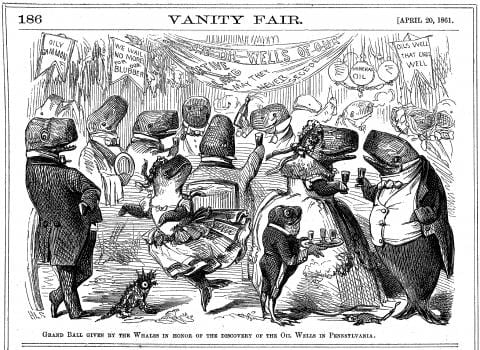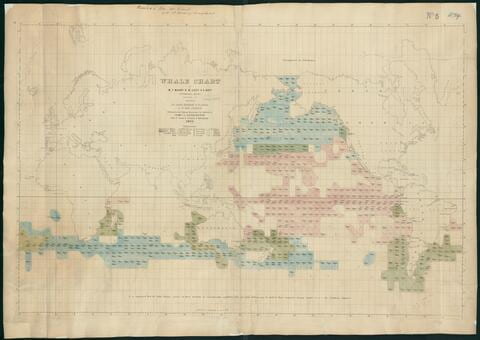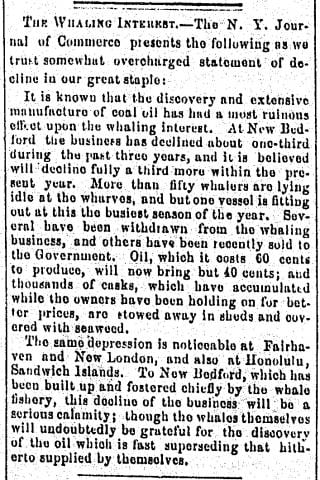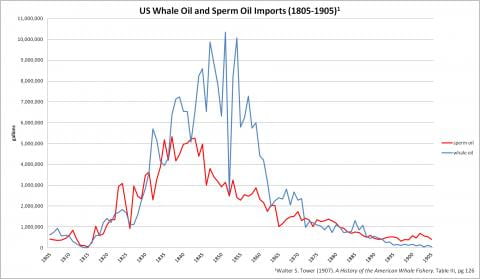Overview
Bathsheba Demuth
This module covers the New England-based commercial whale fishery in the middle of the nineteenth century. The documents cover three themes: how did whalers’ labor on board ship and their dependence on the whale-oil economy shape their ways of valuing and understanding whales; how were transitions from an “organic to a “mineral” energy regime experienced by whalers and whale-oil consumers; and, how did whalers and consumers understand the ecosystem change brought on by energy demands?
In the 19th century, the demand for safe indoor lighting grew alongside American’s population. Before petroleum-derived lamp oils like kerosene became readily available in the 1860s, people lit their homes with energy derived from seed or animal fats. Among these options, whale oil – especially that taken from sperm whales – produced a clean, bright flame with no smell. In the long winters of Boston, New York, Providence and other eastern cities, whale-fueled lamps lit homes and factory floors, streetlamps and the headlights of trains, and guided ships home from lighthouses. Whale oil was also used in the expanding number of factories along the eastern seaboard, as a lubricant for waterwheels and mechanized looms, and as a treatment for fibers used in machine spinning. Whale oil was therefore an organic form of energy – one derived from a living organism, rather than fossilized or “mineral” sources – imbedded in the economies and technologies of early industrialization. Some whaling financers invested their profits from whaling voyages in industrial technologies that would run eventually on fossil fuels, especially early wool and cotton factories, and railroads. But the vast majority of whale oil went to lighting.
By the middle of the nineteenth century, the commercial whaling industry was primarily an American one; of the approximately 900 ships whaling the world’s oceans in the late 1840’s, over 700 flew the U.S. flag. Nantucket and Martha’s Vineyard in Massachusetts and Mystic Connecticut all emerged from the American Revolution and the naval battles of the Napoleonic wars with substantial fleets. But by the 1840s and 1850s, when whale commerce peaked, the industry was concentrated in New Bedford, Massachusetts. With a deep harbor and access to lumber for shipbuilding, New Bedford put to sea hundreds of ships per year. Whaling was one of the state’s most important industries.
The ships that left New Bedford were crewed by men – and whalers were nearly exclusively men, although captains’ wives sometimes traveled with their husbands – from around the world. Some came from American families with long experience in the industry. Others were slaves brought north by the Underground Railroad and smuggled away from slave-catchers aboard ship. Narragansett, Wampanoag, and other Native peoples hired on to whaling crews, as did Native Hawaiians and whalers from the Azores. The demand for lighting sent these diverse crews around the world: from the North Atlantic to the South Atlantic, then as sperm, right, and other whale species grew rarer with sustained hunting, around Cape Horn into the Pacific. Whalers reached Hawaii in 1819, and Honolulu became a major waypoint and place to hire on more crew. By 1848, whaling ships were hunting bowhead whales – a large, especially fatty and therefore particularly valuable – species north of the Bering Strait on voyages lasting over thirty months. On these voyages, whalers bore close witness to whale behavior, and to their shrinking numbers.
In the years they spent at sea, whalers faced constant risks: their financial survival dependent on finding more whales and their physical survival on killing them without dying themselves. Both tasks became more difficult as whale became rarer and learned to be more aggressive toward their hunters, as in the sinking of the whaleship Essex, the inspiration for Herman Melville’s Moby Dick. By the end of the nineteenth century, whalers were encountering another sort of risk – that of vanishing demands for their product. Kerosene became significantly less expensive than whale oil, making light easier for people to afford and whales less valuable. Whalers thus witnessed – and wrote about – the experience of living through the transition from a world fueled mostly by organic energy to one run increasingly on fossil fuels.
Several larger themes in energy history are evident in rise and decline of American whaling. As demand for lighting oil in New England rose, the Yankee fleet drew the United States into the Pacific. Do such imperial dynamics occur with other energy industries? For consumers, the result was more and better light, at least for those able to afford sperm and bowhead whale oil. For these whales, the result was diminished populations. Is ecological destruction an inevitable consequence of growing human energy use? Is there a notable difference between the kind of environmental impact from the large scale commercial use of an organic source like whales, and a mineral source like petroleum? The whaling industry is also an early case of the transition from an organic source of energy to a new mineral equivalent, which makes an entire industry and its expertise, investments, and workers gradually obsolete. Is there anything to be learned from the whaling industry in current debates about coal?
Cite this overview:
Demuth, Bathsheba. “Overview: Harvesting Light: New England Whaling in the Nineteenth Century.” Energy History Online. Yale University. 2023. https://energyhistory.yale.edu/harvesting-light-new-england-whaling-in-the-nineteenth-century/.
Library Items
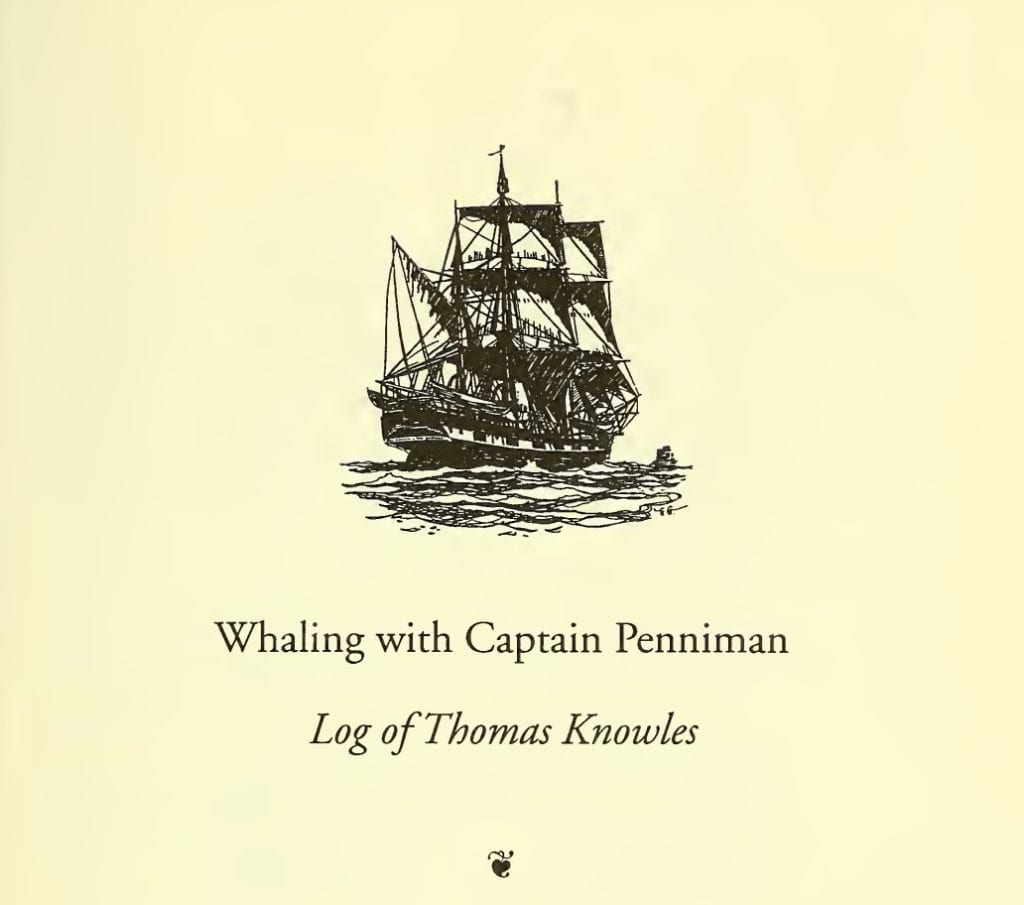
Whaling Log of Thomas Knowles, 1859
Whaling logbooks like this one kept by Thomas Knowles helped to keep track of the ship’s progress, and detailed the experience of whaling.
What are the physical risks of whaling noted by Knowles? What are other difficulties of the voyage? How might these risks shape the way whalers related to their prey?
What kinds of details does the log book contain? What sorts of information seemed important to the whalers in the document, and what is left out?
Whale Map by Matthew F. Maury, 1851
To find more whales, the Yankee whaling fleet moved from the Atlantic into the Pacific. In doing so, they expanded the territory known by the United States and facilitated the expansion of American state power.
“Grand Ball Given by the Whales,” Vanity Fair, April 20, 1861
The first successful commercial oil well was drilled in Pennsylvania in 1859. The rapid adoption of kerosene quickly undercut the use of whale oil for illumination. In this political cartoon in Vanity Fair from April 1861, just one week after the start of the Civil War, whales celebrate the discovery of oil and the possibility of diminished demand for whale oil.
What kinds of cultural and economic challenges might have accompanied the transition from whale oil to petroleum-based kerosene? Who were the “winners” and the “losers” in this energy shift?
“The Whaling Interest,” Whalemen’s Shipping List and Merchants Transcript, New Bedford MA, July 2 1861
Whalers rapidly learned about kerosene and its potential impact on the whaling industry. This 1861 item in the whaling industry’s main newspaper, The Whalemen’s Shipping List, describes the outlook of the industry after the discovery of petroleum in Pennsylvania.
How did the whaling industry characterize this unfolding energy transition? How did whalers think about their future, and the future of whales?

Details on the Whale Oil Trade in New Bedford, 1889
New Bedford’s whaling fleet peaked in 1856 with 329 of a total American fleet of 593 vessels. But the hunt for whales continued after the successful petroleum well in Pennsylvania in 1859. Whale oil continued to be used for a variety of industrial and commercial purposes well into the late 19th century.
What were some of the uses of whale oil described in this 1889 account of the trade? What was the relationship between whale oil and industrialization?
US Imports of Whale Oil and Sperm Oil
When was the peak of the whale oil business? What happened to whale oil imports after the discovery of petroleum in 1859?
Additional Reading
Bockstoce, John R. Whales, Ice, and Men: The History of Whaling in the Western Arctic. Seattle: University of Washington Press, 1986.
Burnett, D. Graham. Trying Leviathan: The Nineteenth-Century New York Court Case that Put the Whale on Trial and Challenged the Order of Nature. Princeton: Princeton University Press, 2010.
Brewster, Mary. She Was a Sister Sailor: The Whaling Journals of Mary Brewster, 1845-1851. Edited by Joan Druett. Mystic, CT: Mystic Seaport Museum, 1992.
Cassell, Mark S. “Iñupiat Labor and Commercial Shore Whaling in Northern Alaska.” The Pacific Northwest Quarterly 91, no. 3 (Summer 2000): 115–23.
Chase, Owen. Narratives of the Wreck of the Whale-Ship Essex. Edited by Thomas Chappel and George Pollard. New York: Dover Publications, 1989.
Creighton, Margaret S. Rites and Passages: The Experience of American Whaling, 1830-1870. New York: Cambridge University Press, 1995.
Demuth, Bathsheba. Floating Coast: An Environmental History of the Bering Strait. New York: W.W. Norton & Company, 2019.
Dolin, Eric Jay. Leviathan: The History of Whaling in America. New York: W.W. Norton, 2007.
Farr, James. “A Slow Boat to Nowhere: The Multi-Racial Crews of the American Whaling Industry.” The Journal of Negro History 68, no. 2 (Spring 1983): 159–70.
Philbrick, Nathaniel. In the Heart of the Sea: The Tragedy of the Whaleship Essex. New York: Penguin Books, 2000.
Russell, Dick. Eye of the Whale: Epic Passage from Baja to Siberia. New York: Simon & Schuster, 2001.
Shoemaker, Nancy. Native American Whalemen and the World: Indigenous Encounters and the Contingency of Race. Chapel Hill: University of North Carolina Press, 2015.
Shoemaker, Nancy. “Whale Meat in American History.” Environmental History 10, no. 2 (April 2005): 269–94.
Author Bio
Bathsheba Demuth is an Assistant Professor of History and Environment and Society at Brown University. She is the author of Floating Coast: An Environmental History of the Bering Strait, (W.W. Norton, 2019).
